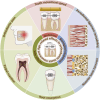The age-related effects on orthodontic tooth movement and the surrounding periodontal environment
- PMID: 39308977
- PMCID: PMC11412856
- DOI: 10.3389/fphys.2024.1460168
The age-related effects on orthodontic tooth movement and the surrounding periodontal environment
Abstract
Orthodontic treatment in adults is often related to longer treatment time as well as higher periodontal risks compared to adolescents. The aim of this review is to explore the influence of age-related chages on orthodontic tooth movement (OTM) from macro and micro perspectives. Adults tend to show slower tooth movement speed compared to adolescence, especially during the early phase. Under orthodontic forces, the biological responses of the periodontal ligament (PDL) and alveolar bone is different between adult and adolescents. The adult PDL shows extended disorganization time, increased cell senescence, less cell signaling and a more inflammatory microenvironment than the adolescent PDL. In addition, the blood vessel surface area is reduced during the late movement phase, and fiber elasticity decreases. At the same time, adult alveolar bone shows a higher density, as well as a reduced osteoblast and osteoclast activation, under orthodontic forces. The local cytokine expression also differs between adults and adolescents. Side-effects, such as excessive root resorption, greater orthodontic pain, and reduced pulpal blood flow, also occur more frequently in adults than in adolescents.
Keywords: age-related changes; aging; alveolar bone; orthodontic tooth movement; periodontal ligament; tooth movement speed.
Copyright © 2024 Wang, Huang, Chen and Li.
Conflict of interest statement
The authors declare that the research was conducted in the absence of any commercial or financial relationships that could be construed as a potential conflict of interest. The author(s) declared that they were an editorial board member of Frontiers, at the time of submission. This had no impact on the peer review process and the final decision.
Figures



Similar articles
-
Mechanisms of Osteoclastogenesis in Orthodontic Tooth Movement and Orthodontically Induced Tooth Root Resorption.J Bone Metab. 2023 Nov;30(4):297-310. doi: 10.11005/jbm.2023.30.4.297. Epub 2023 Nov 30. J Bone Metab. 2023. PMID: 38073263 Free PMC article.
-
Reduced Orthodontic Tooth Movement in Enpp1 Mutant Mice with Hypercementosis.J Dent Res. 2018 Jul;97(8):937-945. doi: 10.1177/0022034518759295. Epub 2018 Mar 13. J Dent Res. 2018. PMID: 29533727 Free PMC article.
-
Mechanosensitive Piezo1 in Periodontal Ligament Cells Promotes Alveolar Bone Remodeling During Orthodontic Tooth Movement.Front Physiol. 2021 Nov 22;12:767136. doi: 10.3389/fphys.2021.767136. eCollection 2021. Front Physiol. 2021. PMID: 34880779 Free PMC article.
-
Is Inflammation a Friend or Foe for Orthodontic Treatment?: Inflammation in Orthodontically Induced Inflammatory Root Resorption and Accelerating Tooth Movement.Int J Mol Sci. 2021 Feb 27;22(5):2388. doi: 10.3390/ijms22052388. Int J Mol Sci. 2021. PMID: 33673606 Free PMC article. Review.
-
Functional Biomaterials for Local Control of Orthodontic Tooth Movement.J Funct Biomater. 2023 May 25;14(6):294. doi: 10.3390/jfb14060294. J Funct Biomater. 2023. PMID: 37367258 Free PMC article. Review.
Cited by
-
Correlation of body mass index and alveolar bone dimensions in the maxilla using cone-beam computed tomography.BMC Oral Health. 2025 Jul 3;25(1):1077. doi: 10.1186/s12903-025-06494-1. BMC Oral Health. 2025. PMID: 40610985 Free PMC article.
-
Association Between Different Biomarkers and Initial Orthodontic Tooth Movement in Children and Adults: A Systematic Review and Meta-Analysis.Cureus. 2025 Feb 4;17(2):e78483. doi: 10.7759/cureus.78483. eCollection 2025 Feb. Cureus. 2025. PMID: 40051942 Free PMC article. Review.
-
GDF15 modulates aging-associated adaptions in the mechanoresponse of periodontal ligament fibroblasts.J Orofac Orthop. 2025 Jul 15. doi: 10.1007/s00056-025-00600-2. Online ahead of print. J Orofac Orthop. 2025. PMID: 40668230 English.
-
Identification of candidate immunity biomarkers associated with age-related variations in osteoclast activity in a mouse model of orthodontic tooth movement.BMC Oral Health. 2025 Aug 12;25(1):1318. doi: 10.1186/s12903-025-06688-7. BMC Oral Health. 2025. PMID: 40797245 Free PMC article.
References
Publication types
LinkOut - more resources
Full Text Sources

